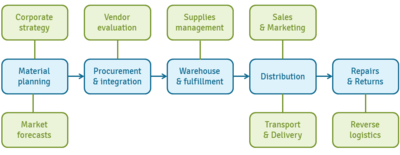Supply logistics subsystem
The tasks carried out within the framework of supply logistics subsystem rely primarily on providing the required raw materials (including support and maintenance), intermediates, spare parts, products and other resources with accompanying information. Goods are delivered to the warehouse of the recipient or directly to the places of their use.
Main task of the supply logistics is to ensure that appropriate goods necessary in the manufacturing process and in maintaining the availability of long-term production are provided. And they meet the requirements of the recipient. Such tasks are specific to the activities of marketing and originally marketing methods was used in the supply area.
The decisions in terms of supply can not be taken without taking into account conditions on the market that are shaped primarily by the following factors:
- Characteristics of the purchased goods - mainly concerning requirements in the fields of transport (means of transport, its accessories), storage (surface area, location, conditions of storage), packaging (size, material) and labelling
- Providers activity - including especially the quantity, degree of compliance with the requirements, opportunity to ensure a long term cooperation, focus on closer cooperation with the customer and mutual improving actions,
- Activities of competitors - primarily the amount, location, scope of impact, sources of supply, potential, logistic solutions used in the area of procurement,
- Restrictions in trading - related to licensing, the need for monitoring by external bodies (i.e. drugs, substances harmful to health)
- International movement of goods - especially because of the differences in the requirements for the transport and storage of goods, the lack of standardization of the documentation of carriage and storage, delays resulting from low bandwidth border crossings.
See also:
Examples of Supply logistics subsystem
- Inventory Management: This involves tracking and managing the flow of incoming and outgoing goods in order to ensure that there is enough stock to meet customer demand. This includes managing the ordering, storing, and shipping of goods.
- Supply Chain Management: This involves optimizing the flow of goods and services from suppliers to customers. This includes managing the procurement, transport, and warehousing of materials.
- Logistics Planning: This involves planning and organizing the effective movement of goods and services from point of origin to point of consumption. This includes route optimization, scheduling, and cost analysis.
- Transportation Management: This involves managing the movement of goods from one location to another. This includes managing the selection of carriers, tracking shipments, and optimizing routes.
- Warehouse Management: This involves managing the storage and retrieval of goods in a warehouse. This includes managing space utilization, stock rotation, and inventory control.
Advantages of Supply logistics subsystem
The main advantages of supply logistics subsystem include:
- Improved efficiency of the supply chain, resulting in reduced costs and improved customer satisfaction.
- Automation of processes and reduction of manual work, which reduces the probability of errors.
- Increased visibility of the supply chain and better communication between stakeholders, allowing for more precise planning and control of the supply chain.
- Enhanced ability to trace, monitor and control the movement of goods, minimizing the risk of loss or theft.
- Greater accuracy of inventory management, reducing the need to stock excess inventory.
- Increased flexibility and responsiveness to changing customer demands.
- Improved supplier management, enabling better selection, monitoring and performance evaluation.
Limitations of Supply logistics subsystem
The limitations of the Supply logistics subsystem include:
- Inaccurate forecasting of demand can lead to shortages or oversupply of materials, which can cause delays in production and increased costs.
- Poorly planned inventory management can lead to inadequate stock levels and reduced efficiency.
- Logistical complexity can cause delays in the supply chain, which can lead to decreased customer satisfaction.
- Lack of effective communication between suppliers, manufacturers, and customers can lead to difficulties in tracking materials and delays in delivery.
- Poor warehouse management can lead to increased costs, inventory shrinkage, and decreased efficiency.
- Poor transportation planning can lead to increased costs, delays, and missed delivery deadlines.
The following approaches are used within the framework of supply logistics subsystem:
- Warehouse Management: This approach focuses on managing the operations of a storage facility and managing the inventory within it. This includes ensuring the right amount of stock is available and ensuring that the quality of the stock is maintained.
- Procurement: This approach focuses on the acquisition of goods, services and materials from external suppliers. This includes selecting the best supplier and negotiating the best possible price.
- Transportation: This approach focuses on the efficient movement of goods from one location to another. This includes selecting the most cost-effective mode of transport and ensuring that the goods arrive safely and on time.
- Distribution: This approach focuses on the efficient delivery of goods to the customer. This includes selecting the best delivery method and ensuring that the customer receives their goods on time.
In summary, the approaches used within the framework of supply logistics subsystem include Warehouse Management, Procurement, Transportation and Distribution. All of these approaches are necessary for ensuring the efficient and effective supply of goods, services and materials.
| Supply logistics subsystem — recommended articles |
| Distribution logistics subsystem — Contract logistics — Production logistics subsystem — Coordinative function of logistics — Material stream — Procurement logistics — Added value (logistics) — Logistics chain — Logistics and transportation |
References
- Farahani, R. Z., Asgari, N., & Davarzani, H. (Eds.). (2009). Supply chain and logistics in national, international and governmental environment: concepts and models. Springer Science & Business Media.
